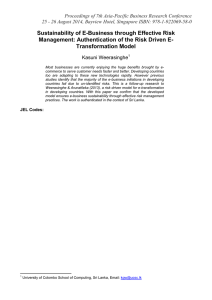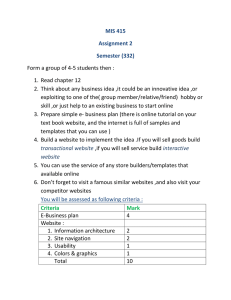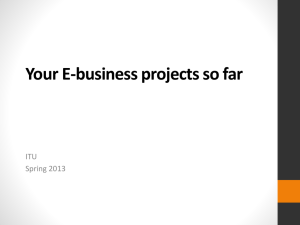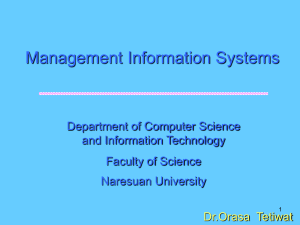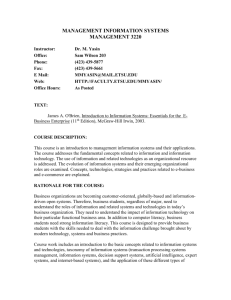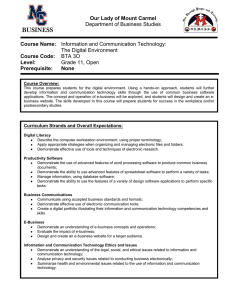Business Data Communications, Fourth Edition Chapter 14: E-Business Applications and the
advertisement
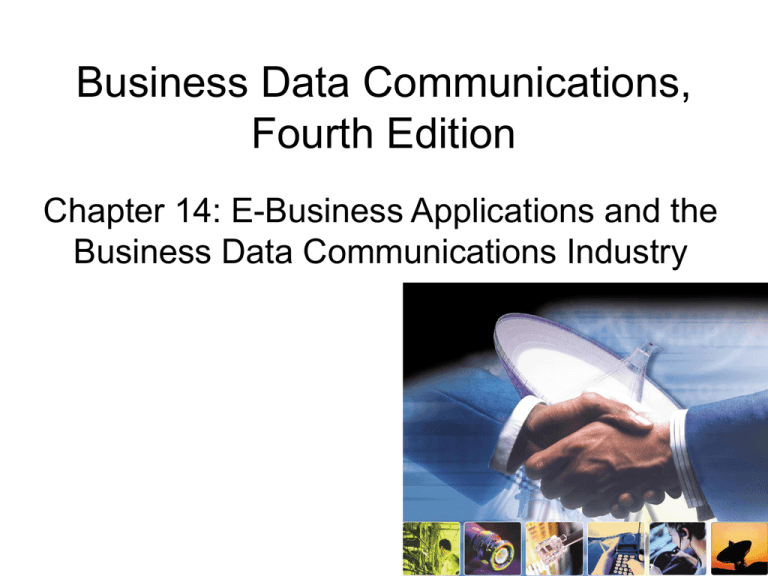
Business Data Communications, Fourth Edition Chapter 14: E-Business Applications and the Business Data Communications Industry Learning Objectives • Describe the effect of e-commerce on information technology (IT) departments • Define the purpose of an application service provider • Identify problems that can occur when businesses conduct transactions over the Internet Chapter 14: E-Business Applications and the Business Data Communications Industry 2 Learning Objectives • Describe the changing attitude toward customers by businesses using the Internet for e-commerce • List e-commerce standards • Describe the use of intranets and extranets for e-commerce • Describe the elements of groupware used to make groups more productive Chapter 14: E-Business Applications and the Business Data Communications Industry 3 Introduction • Business data communications industry is constantly changing • Wide variety of clients used in networks – Clients, servers, telephones, PDAs • New problems and issues exist in ecommerce • Intranets, extranets, groupware are new issues to address Chapter 14: E-Business Applications and the Business Data Communications Industry 4 The Impact of E-Business on Data Communications • E-Business and Information Technology – Network technicians and managers work in IT – Install and maintain the technology – Third era of IT – use of Internet as network of choice – Small businesses must compete with large businesses with use of technology Chapter 14: E-Business Applications and the Business Data Communications Industry 5 The Impact of E-Business on Data Communications • E-Business and Information Technology – Application Service Provider (ASP) • Helps small companies compete in global market – Provide development of applications – Independent Software Vendor (ISV) • Provides Web-enabled applications – Network service provider or Internet service provider needed for Internet access Chapter 14: E-Business Applications and the Business Data Communications Industry 6 Chapter 14: E-Business Applications and the Business Data Communications Industry 7 The Impact of E-Business on Data Communications • E-Business and Information Technology – Data Center Provider providers computer system – Infrastructure/platform provider supplies servers – ASP marketers act as consultants for Webbased businesses – Companies such as Coca-Cola and small companies make use of ASP marketers Chapter 14: E-Business Applications and the Business Data Communications Industry 8 The Impact of E-Business on Data Communications • E-Business and Information Technology – IT Department needs to interact with many departments in e-commerce environment • Shared knowledge is important • IT managers must understand how the company works • Need to understand the flow of data throughout the company to make e-commerce work Chapter 14: E-Business Applications and the Business Data Communications Industry 9 The Impact of E-Business on Data Communications • E-Business and Information Technology – Hardware requirements are different • Palm Pilot – Uses Palm OS which must interact with network and Internet • Smart Pagers • Palm-size PCs • Windows CE easy to incorporate into corporate network, based on Windows • Epoc is new hand-held OS Chapter 14: E-Business Applications and the Business Data Communications Industry 10 The Impact of E-Business on Data Communications • E-Business and Information Technology – Hand-helds used as personal information management tools • E-mail • Sales-force automation • Customer relations – Connections to corporate network • • • • Cradle Direct connection Wireless connections Software Chapter 14: E-Business Applications and the Business Data Communications Industry 11 The Impact of E-Business on Data Communications • E-Business for Business – B2B is new watchword in business journals – Companies need to communicate electronically • G5 Messaging E-accounting initiative • Problems with legality of electronic documents – Problems with accuracy of data • Data warehousing causes large amount of data to be stored • Data cleansing used to get rid of bad data Chapter 14: E-Business Applications and the Business Data Communications Industry 12 The Impact of E-Business on Data Communications • E-Business for Business – Applications • • • • • GlobalNetXchange Worldwide Retail Exchange Covisint Financial services Epylon.com for Education Chapter 14: E-Business Applications and the Business Data Communications Industry 13 The Impact of E-Business on Data Communications • E-Business for Consumers – Consumers are now involved in e-commerce – Information is gathered about the customers by the Web-based business – Customer Resource Management software collects and stores customer information – Preferences are tracked – Example is frequent flyer plans Chapter 14: E-Business Applications and the Business Data Communications Industry 14 The Impact of E-Business on Data Communications • E-Business for Consumers – Determination of why on-line shopping cart is abandoned • Intelligent agent does analysis of potential sale – IT Department must allow access by customers to company applications – Security a big issue – Consumer-centric business • Centered on the needs of customers Chapter 14: E-Business Applications and the Business Data Communications Industry 15 Chapter 14: E-Business Applications and the Business Data Communications Industry 16 The Impact of E-Business on Data Communications • Interactive Television (ITV) – MSN TV used for Internet access without computer • Formerly WebTV – ITV is newest way to access the Internet • • • • Open TV Send e-mail Surf Internet Chat Chapter 14: E-Business Applications and the Business Data Communications Industry 17 The Impact of E-Business on Data Communications • Interactive Television (ITV) – Electronic Programming Guide • First phase of ITV – Enhanced TV • Next phase toward ITV – Total ITV • Full implementation of ITV – Advertisers very interested in ITV Chapter 14: E-Business Applications and the Business Data Communications Industry 18 Standards • Wireless Technology – Advanced Mobile Phone Service (AMPS) • Uses FDMA • One subscriber can use one channel at a time – Time Division Multiple Access (TDMA) • AKA Digital-AMPS or North America TDMA • Uses time slots • Multiple subscribers on transmission line Chapter 14: E-Business Applications and the Business Data Communications Industry 19 Standards • Wireless Technology – Code Division Multiple Access (CDMA) • Uses Spread Spectrum Technology • Code assigned to each segment – Cellular Digital Packet Data (CDPD) • Based on TCP/IP • AKA Wireless IP Chapter 14: E-Business Applications and the Business Data Communications Industry 20 Standards • Wireless Technology – Global System for Mobile Communications (GSM) • European version of TDMA – International Mobile Telecommunications 2000 (IMT-2000) • Third generation of wireless technology • Network access through satellite and terrestrial systems Chapter 14: E-Business Applications and the Business Data Communications Industry 22 Standards • Wireless Technology – Wireless Application Protocol (WAP) • How wireless devices access the Internet • Internet Relationship Management (IRM) used to integrate this technology into business strategy • Need to integrate all types of technology • Other Standards – G5 Messaging E-accounting initiative – AKA Any-to-Any Invoicing • eBIS and BizTalk software have been developed Chapter 14: E-Business Applications and the Business Data Communications Industry 23 Intranets and Extranets • Intranet – Provides internal access to company documents – Not open to the public – Uses Web technology • Extranet – Links company’s business to its partners – Uses Web technology Chapter 14: E-Business Applications and the Business Data Communications Industry 24 Groupware • Facilitates communication among people – E-mail – Videoconferencing – Chat – Collaborative writing systems – Drawing programs • Computer-Supported Cooperative Work – Study of how groups interact – AKA eCollaboration Chapter 14: E-Business Applications and the Business Data Communications Industry 25 Groupware • Real-time Groupware – Whiteboard – Videoconferencing – Chat – Decision Support Systems • Used for brainstorming Chapter 14: E-Business Applications and the Business Data Communications Industry 26 Chapter 14: E-Business Applications and the Business Data Communications Industry 27 Groupware • Asynchronous Groupware – Allows groups to interact at different times – E-mail – Newsgroups and mailing lists – Workflow systems – Group calendar – Collaborative writing systems Chapter 14: E-Business Applications and the Business Data Communications Industry 28 Summary • New challenges for IT department because of e-commerce • New types of hardware need to be integrated into the network • Accounting edocuments can be a problem on different networks • Customer is the main focus of many Web sites • Information is gathered and saved about consumer shopping habits • Interactive TV is the latest technology for accessing the Web without a computer • Standards exist for the new technologies Chapter 14: E-Business Applications and the Business Data Communications Industry 29 Summary (Continued) • AMPS, TDMA, CDMA, CDPD, GSM, IMT2000, and WAP are wireless standards • Intranets are for internal use, while extranets are for external contacts • Groupware can be used for either real time or asynchronous group work Chapter 14: E-Business Applications and the Business Data Communications Industry 30
